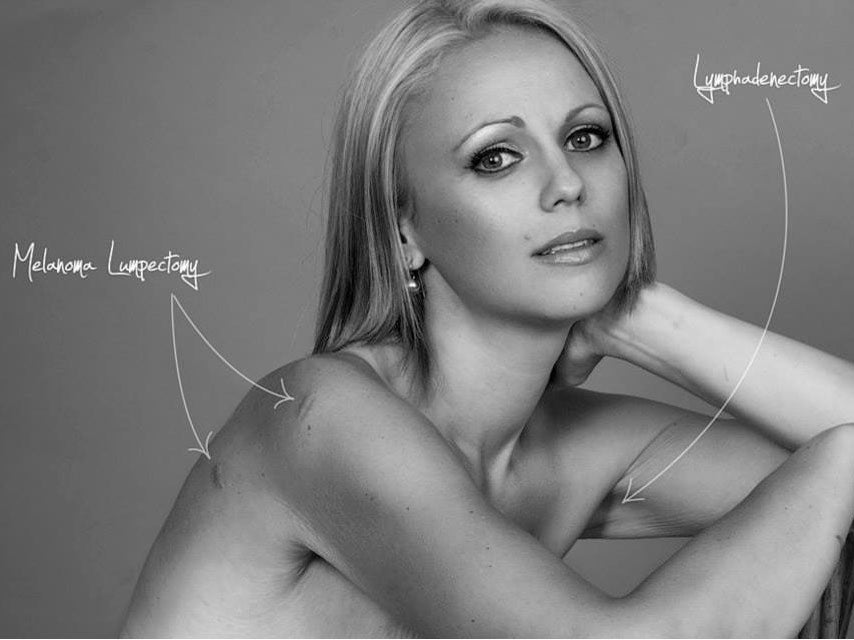Our beautiful scars, dead-drunk kids and radical porcelain
We urgently need to reset our definitions of female beauty before any more young girls are brainwashed


I’ve always said that the “friends” you make on Facebook will never be a replacement for the real sort, ones that turn up in person when you need real help, as opposed to emailing cyber-support. This is an unpopular point of view; the other day I heard an “expert” on the radio discussing Twitter, claiming that it would never replace Facebook as “an important part of our lives”. It is true that Facebook’s appeal crosses all generations and social classes, but the story of the cancer survivor Beth Whaanga demonstrates why I hesitate to join the club.
At 32, Beth was diagnosed with breast cancer. She underwent a double mastectomy followed by reconstructive surgery, as well as preventative operations to remove skin melanomas, lumps in her lymph glands and on her shoulder. Afterwards, instead of being ashamed of her scarred body, Beth decided to post semi-naked pictures of herself online, as part of a consciousness-raising project called Under the Red Dress. She hoped to encourage other women to examine their bodies regularly and check for changes that could be cancerous.
How sensible, and what a bold idea – but not in the feeble world of Facebook cyber-pals. A grand total of 100 of Beth’s followers decided to “unfriend” her, even though she had posted warnings on her page about the images, which also include pictures of her hair loss and her hysterectomy scar. One man wrote: “I personally do not agree with posting confronting pictures on a site where people do not get a choice wether [sic] they wish to view it.”
Since being set up last week, the site has attracted nearly 25,000 “likes” and messages of support, with many people sending in pictures of their own cancer scars. I would go even further than Beth: women need to make all scars sexy – we need to tell the world that scars are like the lines on a tree trunk, they’re part of your DNA, the record of your life.
Tonight, at the Bafta awards, women will walk down a red carpet having spent hours being plastered in make-up and having their hair done. They will be crammed into uncomfortable dresses while wearing controlling underwear and crippling shoes, because they are pathetically succumbing to what society deems “attractive”. Some of these actresses may even have cancer scars, but no one will know. Why should cancer survivors feel less glamorous than anyone else?
As a society, we have a totally warped set of values – there are few images of women that aren’t digitally enhanced to airbrush out imperfections. Angelina Jolie underwent a double mastectomy to reduce her risk of developing breast cancer, and new research indicates that women with the same gene have a much better chance of survival if they follow suit, even if they are young. Some people might argue that young women would be put off self-examination by the brutal images of Beth’s body, because they couldn’t face the potential outcome.
Doesn’t that prove we urgently need to reset our definitions of female beauty before any more young girls are brainwashed?
British art’s Rolling Stone
Richard Hamilton, who died in 2011, was a hugely important artist. His career spanned Pop Art and, through a lifelong interest in Duchamp, reflected all aspects of popular culture for well over half a century. In 2010, he had an exhibition at the Serpentine Gallery, and now his achievements are commemorated simultaneously by three London galleries: at Tate Modern, the ICA and Alan Cristea on Cork Street.
The huge retrospective at Tate Modern includes the iconic stuff we’ve seen before, but the most enchanting work is less familiar, based on shots of people on the beach at Whitley Bay and in Trafalgar Square in the late Sixties, blown up and reduced to abstract blobs. They seem both poignant and evocative. I’m the proud owner of a Richard Hamilton toaster print; like his best work, it never stops being both witty and cool.
Less successful are his political portraits, which come across as naive. Tony Blair as a gunslinger reduces a misguided act of aggression to comic-strip humour, and his prints of the 1970 massacre at Kent State University, taken from news footage on television, turn a horrific scene into something toothless and tasteful.
As for his later work, featuring naked women in Renaissance interiors, I find it, frankly, creepy. Reviewing this show, some critics reckon he’s our best 20th-century artist; I disagree but, at his best, he was the artistic equivalent of the Stones at their peak.
Deadly booze challenge
The drinking game Neknominate has claimed two lives in the UK, where police intend to interview the person who set the challenge that killed 20-year-old Isaac Richardson on 9 February. Filming yourself drinking something disgusting, posting it online and then nominating a “friend” to emulate your achievement has led to several deaths in the UK and Ireland.
Boozing to excess is a rite of passage – generally, the first alcoholic drinks you go for as a teenager are the strongest you’ll ever stomach. I opted for cooking sherry and Scotch as a 14-year-old, and have never drunk either since.
The difference between this game and the usual mindless drinkathons is that potentially fatal ingredients can be included, ranging from urine to faeces and various cleaning products. Isn’t it weird that not one “role model” whom young people might listen to has spoken out against this craze which can only result in more fatalities?
Nick Grimshaw, Rihanna, even dear old Lily Allen, all usually so mouthy on a whole heap of subjects, have collectively said bugger all. Is the silence because they don’t want to appear “uncool”? Just thought I’d ask.
Street art is a sell-out
Royal Doulton used to be the tableware of choice for posh wedding presents, but the company has decided to pursue a new type of customer.
After collaborating with the chef Gordon Ramsay on a tasteful range of dinner plates, it has commissioned a “street art” collection from graffiti artists Nick Walker and Pure Evil, a contemporary of Banksy. Pure Evil is actually Charles Uzzell-Edwards, and his designs for plates and mugs are entitled “Pure Evil in the Pillory” and “Marilyn Marlene Dali”, the latter featuring an image of a woman with running black eye make-up.
Graffiti art as “tableware” seems a tad contradictory – can anything costing £60 for a plate or £18 for a mug really be considered a radical statement? Collectors disagree: much of the range has sold out.

Join our commenting forum
Join thought-provoking conversations, follow other Independent readers and see their replies